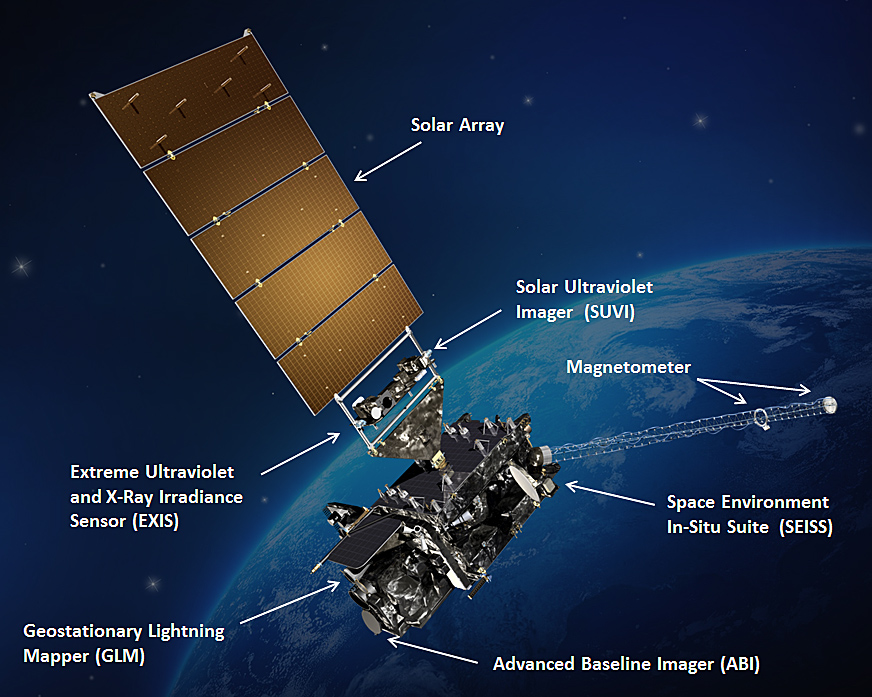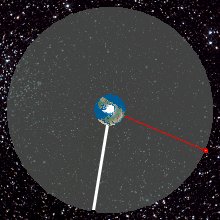|
Elektro-L No.2
Elektro-L No.2 is a Russian geostationary weather satellite which launched on 11 December 2015. It is the second Elektro-L spacecraft to fly, after Elektro-L No.1 launched in 2011. The Elektro-L No. 2 satellite system was developed by Lavockhin and is part of the second generation of Russian geosynchronous weather satellites. The space platform has an upgrade in star trackers (EADS Sodern SED26) and radio complex. The MSU-GS camera also passed additional tests to improve performance in infrared channels. Launch Originally planned for 2014, the launch date was December 11, 2015 at 13:45:33 UTC. The launch was conducted using a Zenit-3F carrier rocket from the Baikonur Baikonur ( ; ) is a city in Kazakhstan on the northern bank of the Syr Darya river. It is currently leased and administered by the Russian Federation as an enclave until 2050. It was constructed to serve the Baikonur Cosmodrome with adminis ..., site 45/1. References External links Orbital Track ... [...More Info...] [...Related Items...] OR: [Wikipedia] [Google] [Baidu] |
Weather Satellite
A weather satellite or meteorological satellite is a type of Earth observation satellite that is primarily used to monitor the weather and climate of the Earth. Satellites are mainly of two types: polar orbiting (covering the entire Earth asynchronously) or geostationary (hovering over the same spot on the equator). While primarily used to detect the development and movement of storm systems and other cloud patterns, meteorological satellites can also detect other phenomena such as city lights, fires, effects of pollution, auroras, sand and dust storms, snow cover, ice mapping, boundaries of ocean currents, and energy flows. Other types of environmental information are collected using weather satellites. Weather satellite images helped in monitoring the volcanic ash cloud from Mount St. Helens and activity from other volcanoes such as Mount Etna. Smoke from fires in the western United States such as Colorado and Utah have also been monitored. El Niño and its effects on wea ... [...More Info...] [...Related Items...] OR: [Wikipedia] [Google] [Baidu] |
Roskosmos
The State Corporation for Space Activities "Roscosmos", commonly known simply as Roscosmos (), is a state corporation of the Russian Federation responsible for space flights, cosmonautics programs, and aerospace research. Originating from the Soviet space program founded in the 1950s, Roscosmos emerged following the dissolution of the Soviet Union in 1991. It initially began as the Russian Space Agency,, ''Rossiyskoye kosmicheskoye agentstvo'', or RKA (). which was established on 25 February 1992 and restructured in 1999 and 2004 as the Russian Aviation and Space Agency, ''Rossiyskoye aviatsionno-kosmicheskoye agentstvo'', commonly known as (), established on 25 May 1999. and the Federal Space Agency (Roscosmos), (Роскосмос), ''Federalnoye kosmicheskoye agentstvo (Roskosmos)''. respectively. In 2015, the Federal Space Agency (Roscosmos) was merged with the United Rocket and Space Corporation, a government corporation, to re-nationalize the space industry ... [...More Info...] [...Related Items...] OR: [Wikipedia] [Google] [Baidu] |
Navigator (satellite Bus)
A navigator is the person on board a ship or aircraft responsible for its navigation.Grierson, MikeAviation History—Demise of the Flight Navigator FrancoFlyers.org website, October 14, 2008. Retrieved August 31, 2014. The navigator's primary responsibility is to be aware of ship or aircraft position at all times. Responsibilities include planning the journey, advising the ship's captain or aircraft commander of estimated timing to destinations while en route, and ensuring hazards are avoided. The navigator is in charge of maintaining the aircraft or ship's nautical charts, nautical publications, and navigational equipment, and they generally have responsibility for meteorological equipment and communications. With the advent of satellite navigation, the effort required to accurately determine one's position has decreased by orders of magnitude, so the entire field has experienced a revolutionary transition since the 1990s with traditional navigation tasks, like performing ... [...More Info...] [...Related Items...] OR: [Wikipedia] [Google] [Baidu] |
NPO Lavochkin
NPO Lavochkin (, OKB-301, also called Lavochkin Research and Production Association or shortly Lavochkin Association, LA) is a Russian aerospace company. It is a major player in the Russian space program, being the developer and manufacturer of the Fregat upper stage, as well as interplanetary probes such as Fobos-Grunt. As of 2015, it was headed by Sergei Lemeshevskii. On 10 August 2017 the Lavochkin Association's Board of Directors appointed Vladimir Kolmykov Director General of the enterprise. Overview The company develops and manufactures spacecraft such as the Fregat rocket upper stages, satellites and interplanetary probes. It is a contractor for a number of military programs, such as the Oko early warning satellite, Prognoz (satellite), Prognoz and Araks programmes as well as the civilian program Kupon (satellite), Kupon. One of the company's most notable projects was the participation in the failed Fobos-Grunt sample return mission. NPO Lavochkin has also developed the El ... [...More Info...] [...Related Items...] OR: [Wikipedia] [Google] [Baidu] |
Zenit-3F
The Zenit-3F, Zenit-3SLBF or Zenit-2SB/Fregat was an expendable carrier rocket. It was a member of the Zenit family of rockets, which were designed by Yuzhnoye Design Bureau of Ukraine Ukraine is a country in Eastern Europe. It is the List of European countries by area, second-largest country in Europe after Russia, which Russia–Ukraine border, borders it to the east and northeast. Ukraine also borders Belarus to the nor .... Launches of Zenit-3SLBF rockets were conducted from Baikonur Cosmodrome Site 45/1. The rocket consisted of a Zenit-2SB (Zenit-2M) core vehicle, with a Fregat-SB upper stage, developed by NPO Lavochkin of Russia, in place of the Block-DM used on the Zenit-3SL and 3SLB. The first launch of a Zenit-3F took place on 20 January 2011. The payload was an Elektro-L new generation weather satellite. A Zenit-3F was also used to successfully launch the Spektr-R radio astronomy satellite on 18 July 2011. Launches References {{rocket-stub ... [...More Info...] [...Related Items...] OR: [Wikipedia] [Google] [Baidu] |
Baikonur Cosmodrome
The Baikonur Cosmodrome is a spaceport operated by Russia within Kazakhstan. Located in the Kazakh city of Baikonur, it is the largest operational space launch facility in terms of area. All Russian Human spaceflight, crewed spaceflights are launched from Baikonur. Situated in the Kazakh Steppe, some above sea level, it is to the east of the Aral Sea and north of the Syr Darya. It is close to Töretam, a station on the Trans-Aral Railway. Russia, as the official successor state to the Soviet Union, has retained control over the facility since 1991; it originally assumed this role through the post-Soviet Commonwealth of Independent States (CIS), but ratified an agreement with Kazakhstan in 2005 that allowed it to lease the spaceport until 2050. It is jointly managed by Roscosmos and the Russian Aerospace Forces. In 1955, the Ministry of Defense (Soviet Union), Soviet Ministry of Defense issued a decree and founded the Baikonur Cosmodrome. It was originally built as the chief ... [...More Info...] [...Related Items...] OR: [Wikipedia] [Google] [Baidu] |
Baikonur Cosmodrome Site 45
Site 45 at the Baikonur Cosmodrome used to be a Zenit rocket launch site consisting of two pads, both of which are currently inactive. It used to be the launch site for all Soviet and Russian government Zenit launches, along with a commercial launch conducted for Globalstar in 1998, and continuing commercial launches under the Land Launch programme. The main pad at the site is area 45/1, which was completed in 1983 following five years of construction. A second pad, area 45/2, was completed in 1990, but was destroyed by a launch failure in the same year. The first launch from site 45, using pad 1, occurred on 13 April 1985. This was a sub-orbital test flight of the Zenit-2, and the maiden flight of the Zenit rocket. The launch failed, and was followed up with a second, successful, test flight launched at 08:21 GMT on 21 June 1985. Whilst this launch was also intended to be suborbital, some debris from the launch reached low Earth orbit. The first launch from pad 2 occurred on 22 ... [...More Info...] [...Related Items...] OR: [Wikipedia] [Google] [Baidu] |
Geocentric Orbit
A geocentric orbit, Earth-centered orbit, or Earth orbit involves any object orbiting Earth, such as the Moon or artificial satellites. In 1997, NASA estimated there were approximately 2,465 artificial satellite payloads orbiting Earth and 6,216 pieces of space debris as tracked by the Goddard Space Flight Center. More than 16,291 objects previously launched have undergone orbital decay and entered Earth's atmosphere. A spacecraft enters orbit when its centripetal acceleration due to gravity is less than or equal to the centrifugal acceleration due to the horizontal component of its velocity. For a low Earth orbit, this velocity is about ; by contrast, the fastest crewed airplane speed ever achieved (excluding speeds achieved by deorbiting spacecraft) was in 1967 by the North American X-15. The energy required to reach Earth orbital velocity at an altitude of is about 36 MJ/kg, which is six times the energy needed merely to climb to the corresponding altitude. Spa ... [...More Info...] [...Related Items...] OR: [Wikipedia] [Google] [Baidu] |
Geostationary Orbit
A geostationary orbit, also referred to as a geosynchronous equatorial orbit''Geostationary orbit'' and ''Geosynchronous (equatorial) orbit'' are used somewhat interchangeably in sources. (GEO), is a circular orbit, circular geosynchronous orbit in altitude above Earth's equator, in radius from Earth's center, and following the retrograde and prograde motion, direction of Earth's rotation. An object in such an orbit has an orbital period equal to Earth's rotational period, one sidereal time, sidereal day, and so to ground observers it appears motionless, in a fixed position in the sky. The concept of a geostationary orbit was popularised by the science fiction writer Arthur C. Clarke in the 1940s as a way to revolutionise telecommunications, and the first satellite to be placed in this kind of orbit was launched in 1963. Communications satellites are often placed in a geostationary orbit so that Earth-based satellite dish, satellite antennas do not have to rotate to track t ... [...More Info...] [...Related Items...] OR: [Wikipedia] [Google] [Baidu] |
Weather Satellite
A weather satellite or meteorological satellite is a type of Earth observation satellite that is primarily used to monitor the weather and climate of the Earth. Satellites are mainly of two types: polar orbiting (covering the entire Earth asynchronously) or geostationary (hovering over the same spot on the equator). While primarily used to detect the development and movement of storm systems and other cloud patterns, meteorological satellites can also detect other phenomena such as city lights, fires, effects of pollution, auroras, sand and dust storms, snow cover, ice mapping, boundaries of ocean currents, and energy flows. Other types of environmental information are collected using weather satellites. Weather satellite images helped in monitoring the volcanic ash cloud from Mount St. Helens and activity from other volcanoes such as Mount Etna. Smoke from fires in the western United States such as Colorado and Utah have also been monitored. El Niño and its effects on wea ... [...More Info...] [...Related Items...] OR: [Wikipedia] [Google] [Baidu] |




